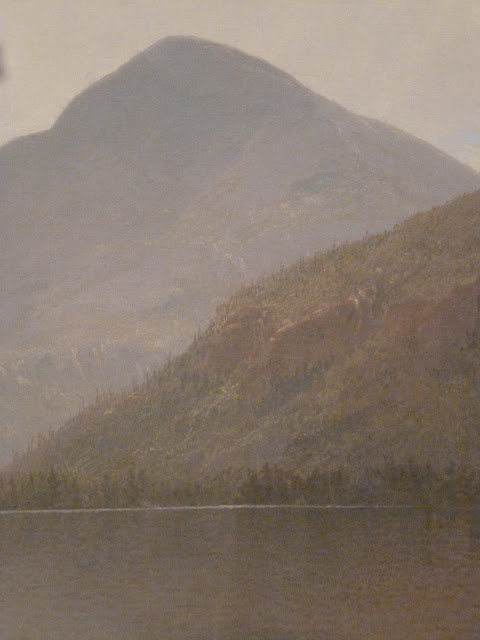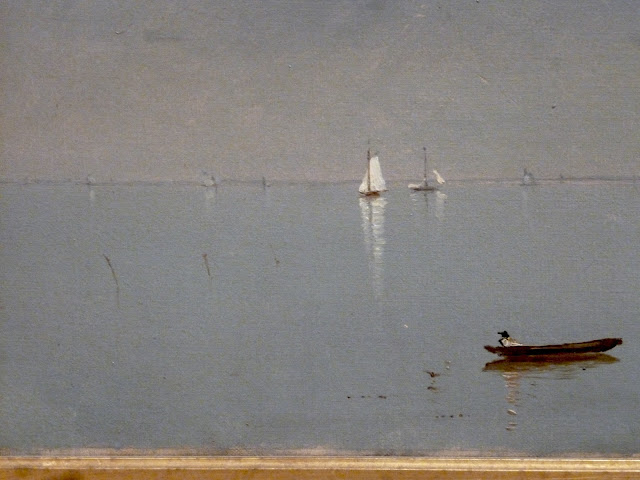The Metropolitan Museum contains 3 of the most famous and important paintings to come out of the Civil War. Winslow Homer's Prisoners from the Front and Veteran in a New Field are housed in the Met. Another Civil War painting whose fame has diminished over time, George Inness' Peace and Plenty also resides in the Met in the American Wing of the museum. A large painting, it hangs in the same gallery as big spectacular paintings by Bierstadt and Church, and with Emanuel Leutze's Washington Crossing the Delaware. Most visitors now walk past this painting on the way to look at George Washington standing up in his boat, but at one time (and not that long ago) this was a celebrated and much discussed painting. Unlike the paintings by Church and Bierstadt in that gallery, Inness' large painting is deliberately unspectacular, but still very beautiful. Inness rejected the exotic locations of Church and the dramatic special effects in the western landscapes of Bierstadt. Like John Frederick Kensett, Inness preferred the much more familiar and settled landscapes of New York state, New Jersey, and Pennsylvania. When he traveled to paint landscapes abroad, it was to the Apennines, not the Andes. And yet, Inness was among the most religiously and philosophically thoughtful of American landscape painters.
Unless otherwise noted, all of these photographs are mine and are freely available especially to educators.
I've always thought it remarkable that the bloodiest conflict in the history of the USA produced so little violent or even tragic art. The only exceptions would be the photographs by Alexander Gardner and Matthew Brady of corpse strewn battlefields at places like Gettysburg and Antietam. Most of the art from that time shows anecdotes from the soldier's life such as Winslow Homer's paintings, triumphalist allegories such as the monuments made by Augustus Saint Gaudens or Daniel Chester French, or very distantly allusive landscapes such as this painting, Peace and Plenty completed by Inness in 1865, the year the war ended. This painting helped establish him as a major American landscape artist and was a deliberate rejection of the literalism and spectacle of artists such as Church and Bierstadt.
While some artists like Bierstadt bought their way out of the Civil War, Inness went straight to the recruitment office when the War began. He was an ardent abolitionist and supported the Union cause whole-heartedly. He failed the physical exam for the military, so he organized rallies and gave speeches to rally volunteers and funds to the Union cause. Inness finished Peace and Plenty in 1865 and first exhibited it in 1866. Ever since that first exhibit, critics and scholars offered numerous detailed interpretations of the picture. It clearly reflects the relief and optimism of many on the Union side at the end of the Civil War and the end of slavery. But, many suggest that it may mean more. According to the historian Leo Mazow, the original owners of Peace and Plenty, Marcus and Rebecca Spring, were utopian social reformers who founded the Eagleswood Military Academy in Perth Amboy, NJ as a place for the reconciliation of social classes. There may be some of that in this painting in the many figures seen working together to bring in the harvest. Early in his life, in 1851 during his first trip to Europe, Inness met the portraitist William Page who introduced him to both the painterly style of Titian and the writings of the Christian mystic Emanuel Swedenborg, two enduring influences on his life and work. Some writers suggest that the radiant glowing light of early evening or late morning in this painting may allude to Swedenborgian concepts of the New Jerusalem already immanent in the world. Perhaps. Though I think such ideas may inform the conception of the painting, I don't see this as a particularly mystical picture.
I remember reading somewhere, I don't remember where, a critic who interpreted the scattered bails of harvested wheat as recalling the bodies of the dead scattered on the battlefield; an interesting idea, but I think unlikely. The tranquil glowing light and deep lush colors of the painting more surely express the idea of peace and plenty than any symbolism or allusions that may or may not be in this painting. Peace and Plenty meant far more to Inness in this picture than simply an upswing in the economic cycle following a military victory. This is a triumphalist painting celebrating the Union victory as a chance for a new start; but, it is not General Sherman's horse trampling the pine branch of defeated Georgia in Saint Gauden's statue in Central Park. I think Inness wanted somehow console with this picture. Its harvest, golden light dispelling dark shadows, lush greenery, and especially the quiet tone of the picture may be mindful of the appalling death and destruction of the war, that somehow the painting echoes Lincoln's plea "that these dead shall not have died in vain." There is a memorial quality, an underlying solemnity in this painting similar to the quiet glow of Everlasting Rest in another painting in the Metropolitan Museum by Asher B. Durand, Landscape -- Scene From "Thanatopsis" based on a meditation on death by the poet William Cullen Bryant. Perhaps Inness intended this painting to hint at some form of resurrection in the renewing seasons, or rest of the blessed in Elysian Fields.
Yet not to thine eternal resting-place
Shalt thou retire alone, nor couldst thou wish
Couch more magnificent.
Thou shalt lie down
With patriarchs of the infant world—with kings,
The powerful of the earth—the wise, the good,
Fair forms, and hoary seers of ages past,
All in one mighty sepulchre.
The hills Rock-ribbed and ancient as the sun,—the vales
Stretching in pensive quietness between;
The venerable woods—rivers that move In majesty, and the complaining brooks
That make the meadows green; and, poured round all,
Old Ocean’s gray and melancholy waste,—
Are but the solemn decorations all
Of the great tomb of man.
The golden sun,
The planets, all the infinite host of heaven,
Are shining on the sad abodes of death,
I think it does Inness an injustice to read too literal a set of meanings into this picture. Inness worked hard all his life to avoid the anecdotal literalism that we can see in paintings by Church or Bierstadt (or even my work). This is certainly a far less literal minded painting than Asher B Durand's Landscape -- Scene From "Thanatopsis."
Inness succeeded beautifully in Peace and Plenty, suggesting so many levels of meaning without spelling everything out for us.
***
Inness during his stay in Paris became deeply influenced by the very open and painterly style of the Barbizon landscape painters (so called because they settled and worked together in the village of Barbizon in France), especially Theodore Rousseau, who in turn learned this new way of suggesting rather than describing from the great English painter John Constable. Incidentally, as I learned during my trip to Amsterdam in 2014, another great painter who looked continuously to the Barbizon painters for guidance and inspiration was Vincent Van Gogh.
Like the Barbizon painters and Constable, Inness was less interested in taking inventory of the natural world than in conjuring it out of paint on canvas, out of the big dramas of light and dark and color and letting the paint and brushes work their magic instead of hiding them behind heavy varnishes and smooth surfaces.
I've always loved this painting by Inness of the Delaware Water Gap on the border between New Jersey and Pennsylvania, one of several that he made of the Gap, and probably the best of them. This painting is as full as the later landscapes of John Frederick Kensett are empty.
This painting, like so many of Inness' paintings, shows long settled and inhabited country. As in much of his work, there is productive activity going on, in this case transportation up and down and beside the Delaware river. What appear to be rafts, perhaps of newly cut timber, float down the river in the center. A train heads toward the left side of the painting parallel to the river. Cattle graze in the foreground with a young man resting on the grass.
Sunlight shines on a beautifully painted summer shower and casts a rainbow.
The land in Inness' work is seldom if ever primordial wilderness. The relation between the land and the people who live on it is almost always peaceful and harmonious. Through all the seasons, the times of day, though all conditions of weather, the relation between nature and its human inhabitants always seems familiar and friendly. This is very different from Brueghel's peasants dependent for their existence on the whims of a vast, mysterious, and indifferent nature with its cycles.
Perhaps these landscapes express Inness' Swedenborgian beliefs in immanent spirituality. More likely those beliefs, together with his knowledge of American Transcendentalism, inform these paintings.
Also informing Inness' landscapes may be his political views. By the standards of Inness' day and ours, he was a fighting liberal, an enthusiastic follower of several progressive causes including the rights of labor. Late in life, he became friends with the social reformer Henry George and a follower of his single tax theories. There is frequently a happy harmony in his paintings between people and nature, and among individuals as well. His paintings envision a happiness that is there latent in the world and among ourselves if we only open our eyes and look for it.
Below is a magnificent small painting from later in Inness' life, Autumn Oaks from 1878
It is beautifully colored with a splendid composition focusing on a stand of oak trees on the right, spot lit by the sun through passing clouds. The bull in the foreground directs us to the wide open and spreading countryside on the left.
George Innes in 1890, photo from Wikimedia
I've loved Inness' work for many years, since even before I went to art school.
I gather that Inness has something of a cult following. His paintings, though respected, are not the crowd pleasers that Church's paintings are (or Winslow Homer's paintings are for that matter). His work went in and out of the critical doghouse during the 20th century. Museums deaccessioned a lot of his work to private collections at one point. Many of his paintings show signs of neglect in yellowed and dirty varnish that still covers a lot of his work, even in the Met. Even Peace and Plenty could use a good cleaning and a little refreshing. Those paintings that are cleaned and restored like The Delaware Water Gap reveal what a rich and poetic colorist Inness was at his best.


































































